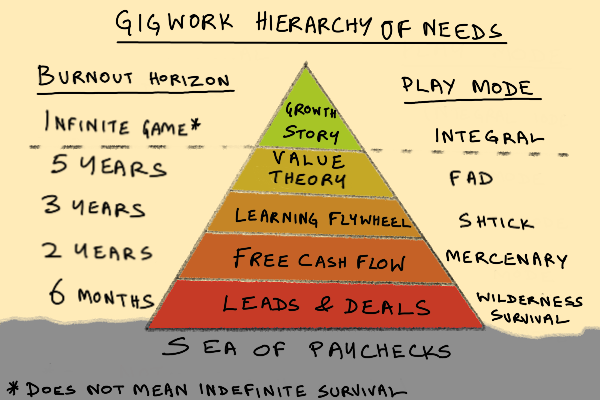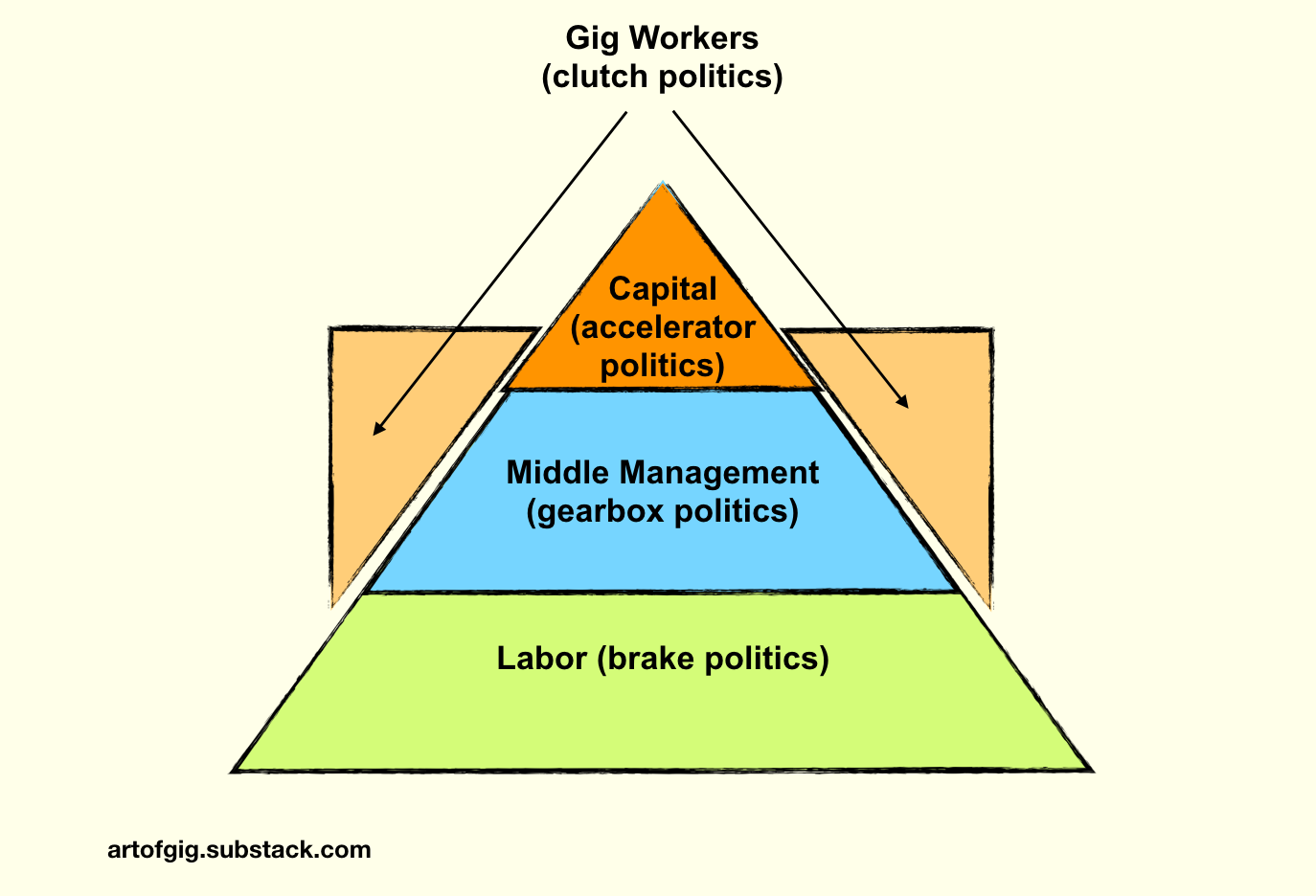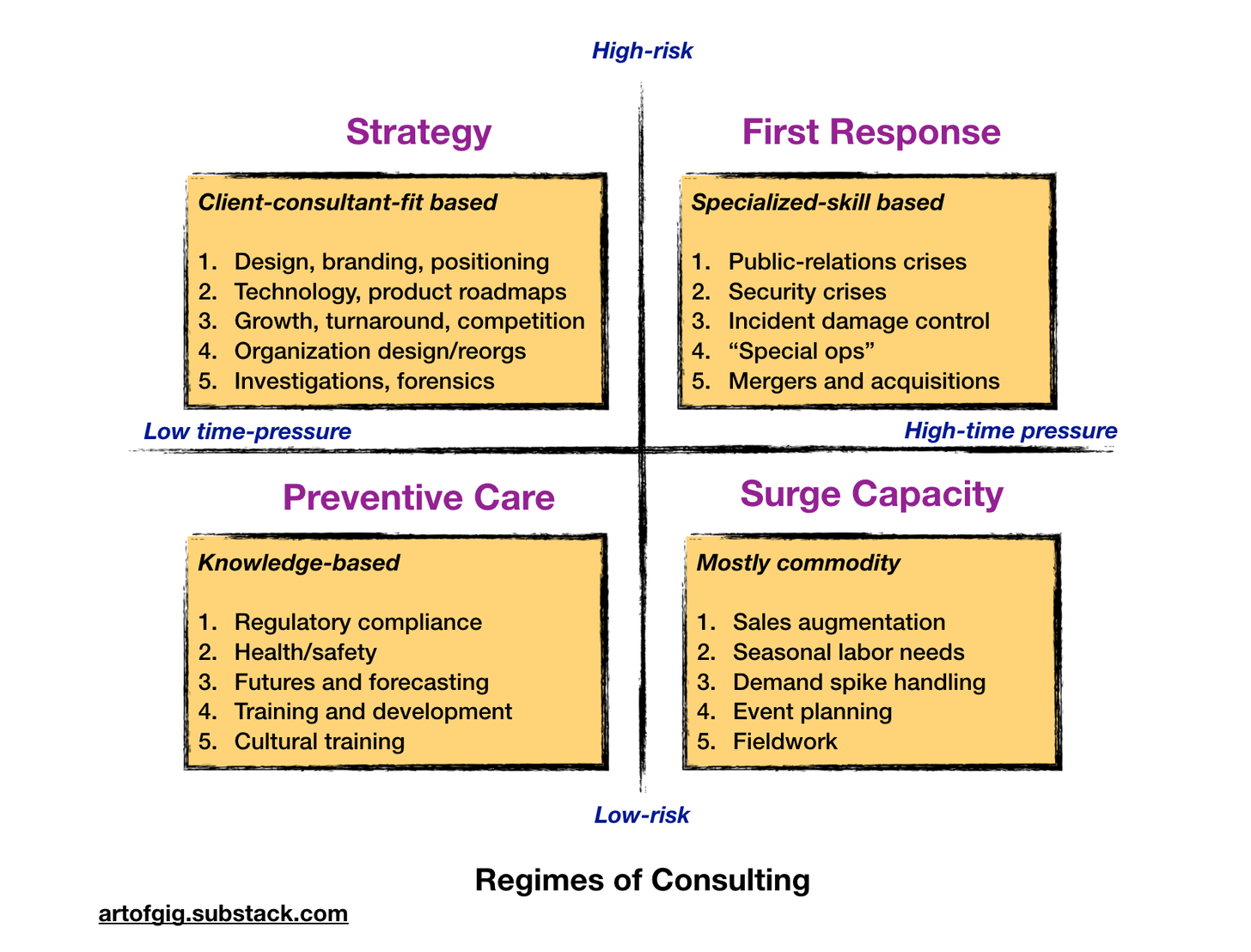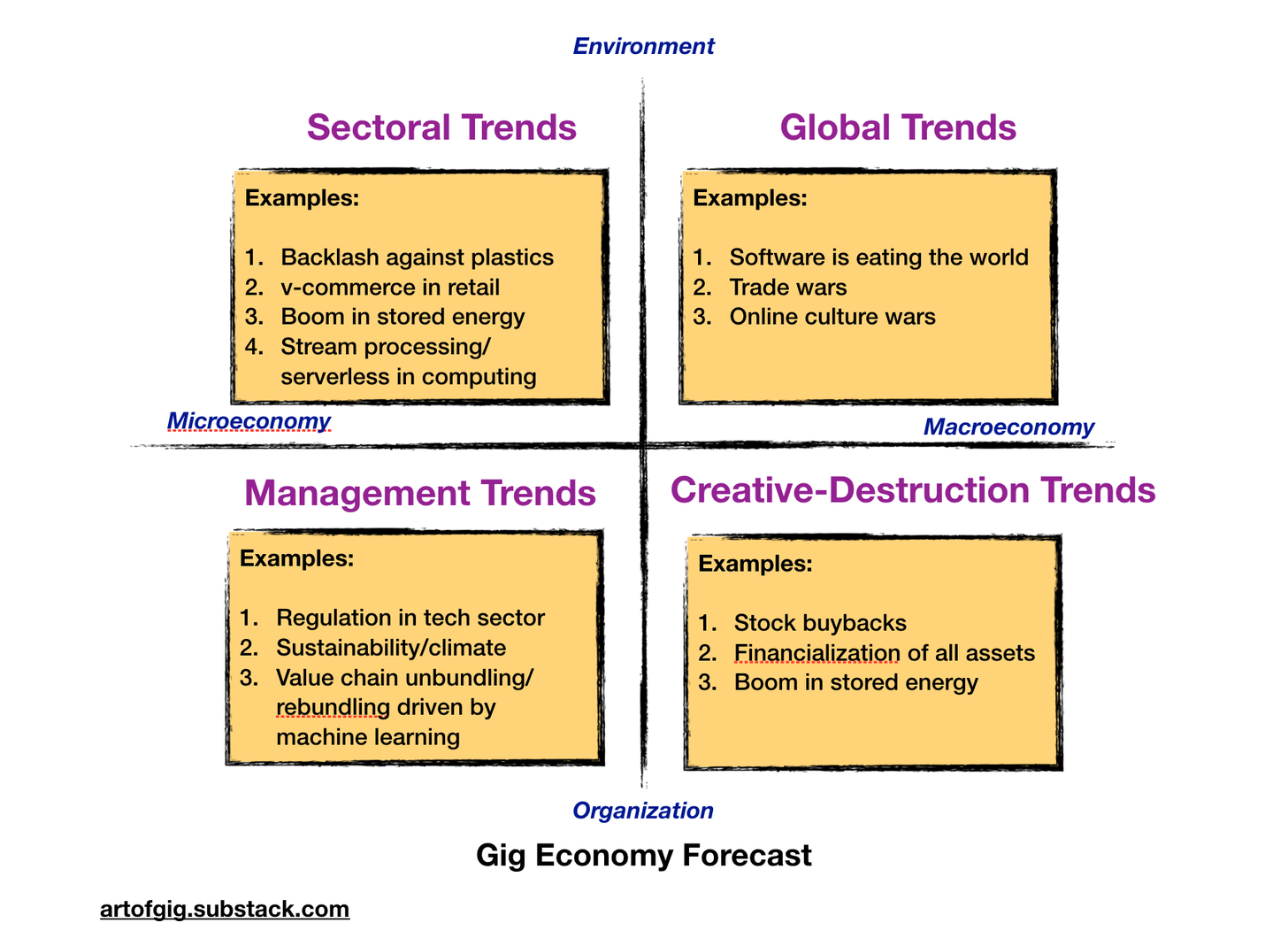Gig work is seasonal, but not in the way nature or traditional trade and businesses sectors are seasonal. One of the most powerful aspects of gig work is that it gives you as much agency over your own time as you are capable of imagining and exercising (something the lawmakers in California seem intent on destroying, given the recent passage of AB 5).
Rather than being at the mercy of the natural or business seasons that govern your environment, you make your own seasons. And to help you do that, I want to introduce you to an ancient and powerful personal future divination tool, used by gig workers for centuries, called the Yak Zodiac (sometimes informally written as zodiyak).
Like the regular zodiac, the Yak Zodiac has 12 signs, but unlike the regular zodiac, it has no fixed temporal order, and no fixed mapping to constellations or the astronomical calendar. The signs also do not map to a fixed duration: depending on context, they might map to a minute, a month, or a year. Finally, each can appear more than once in a temporal narrative sequence.
The Yak Zodiac is a tool to help you make up your own calendar, marking your own seasons, with great control over sequence, duration, and repetition. There are rules, but they are not the familiar, rigid astrological ones, derived from the movements of stars and planets (or stock markets and fads). Instead they are in the form of a large variety of rule sets drawn from a rich tradition of divination games, much of which has sadly been lost.
The tradition represents a history of grappling with an insight that ancients stumbled upon that is increasingly relevant today: not only can you make up your own seasons, you must make your own seasons. Otherwise you succumb to the dreadful malaise of independent consulting: atemporality.
Where it’s never the beginning or end of anything for you (even if it is for your clients).
Where despite all the craziness, ups and downs, and cash-flow volatility, somehow, mysteriously, yesterday always looks like tomorrow.
Where it’s always Mild Panic Midseason.
Shakespeare knew all about atemporality:
To-morrow, and to-morrow, and to-morrow,
Creeps in this petty pace from day to day,
To the last syllable of recorded time;
And all our yesterdays have lighted fools
The way to dusty death.
Curiously, these words are spoken by Macbeth, upon the death of his consultant-wife by suicide (unlike me, Lady Macbeth was totally evil rather than slightly evil, so let that be a warning to you, in case you are tempted by the Dark Side of the art of gig)
If you can’t stomach Shakespeare, atemporality for the gig worker is like the Mad Hatter’s Tea Party in Alice in Wonderland. It’s always teatime. It’s always 4 PM. And you’re always just going around a table piled with dirty dishes with friends as trapped in atemporality as you.
To break out of atemporality and take control of your life, while acknowledging and accommodating the forces that are beyond your control, you need to make your own seasons.
You need to make your own time. You need the Yak Zodiac.
History and Origins
Though much of the esoteric knowledge associated with the Yak Zodiac has sadly been lost, I have been able to reconstruct enough of it through my research to start practicing divination with it.
As I explained in The Secret History of Consulting: 1, the ancient roots of the consulting world lie in astrology, and it appears that somewhere along the way, ancient consultants decided they needed a tool that allowed them to invent the future rather than merely reveal it. The Yak Zodiac first appears (though not in its mature form) in various places along the Silk Road in the 6th century BC. Curiously, there is evidence that though the system was neither a secret, nor restricted to any group, it was rarely used by consultants on behalf of clients. Clients, it seemed, preferred the dismal certainties of the traditional zodiac over the unsettling agency of the Yak Zodiac.
The picture above is a photograph (excuse the poor quality) of a set of 12th century Yak Zodiac terracotta seals from Central Asia, owned by a friend of mine, a private collector and retired consultant in Zurich, who prefers to remain anonymous.
It is one of the last surviving complete sets, but apparently, at one time, most consultants working along the Silk Road carried a set in a small pouch (usually containing multiples of each tile), and played a variety of divination games with them, both alone and with each other, and on rare occasions, with clients.
I’ll share what I’ve been able to reconstruct of a few beginner games in a minute, but let me introduce the 12 signs first.
The Anchor
By one theory, our modern term “anchor client” can actually be traced to the Yak Zodiac symbol of the Anchor. In the ancient Near East, it was generally taken to symbolize a period of safe and reliable, but transient and fragile, refuge. A period governed by the anchor was a period of respite from the more extreme vagaries of consulting life.
The Zither
The zither, a common musical instrument across Asia and Europe, symbolized a period of poeisis, where you could expect to find the beauty in whatever you were up to. It would be a mistake, however, to interpret the zither as a sign of relaxation, leisure, and calm. The zither portends strains of beauty and poetry, and meaning-making, but does not promise freedom from risk or emotional repose.
The Four Moons
This is one of the most important tiles. The Four Moons, as best as we can reconstruct today, was the ancient equivalent of the modern indie consulting time zone, familiar to all of us, known as Waiting for Invoice Payment. A period marked by delayed fulfillment of expectations, and growing risk of non-payment, where you can neither easily move on, nor usefully act to change things. It is curious that four moons — about 120 days given a lunar month of 29.5 days — has remained the modern standard for “okay now it’s really late,” since large corporate invoices are often 90 days. So if you’ve been waiting 4 moons, it’s probably late on a big invoice and you’re in trouble. Though it generally marks a period of growing helplessness, it can also be interpreted as a period of development of strength, patience, resilience, resourcefulness, and other stoic virtues. A Four Moons period that does not kill you only makes you stronger.
The Bricks
The Bricks, of course, symbolize a period of building, consolidation, and accumulation of permanence and durability, often during a period of surplus time and/or money. In the volatile seas of free agency, periods when you can work on adding to an enduring core to your life are rare, and you must make the most of them. In many divination games, the Bricks tile is the only one to be assigned a fixed calendar position (often the month of August), since they have a tendency to line up with the slow seasons of the client sector being served.
The Oasis
The Oasis represents a nourishing, relaxing, and sociable break in what can otherwise be a struggle for survival in a hostile, endless desert of scarce resources. But beware — one cannot stay at an Oasis for ever! You must move on. The Oasis often represents a longer-than-normal gig with lots of room for creativity and relatively few constraints from the generous client or benefactor. Make the most of Oasis periods, but do not let yourself get lazy or too comfortable! I happen to be in an extended Oasis gig myself right now.
The Rain
The Rain is one motif that has retained its ancient symbolism. Today, we often refer to bringing in gigs or leads as rain-making. In the Yak Zodiac, the Rain can signify either a period of natural rain (ie unearned abundance), or a period or rainmaking, which may or may not actually work. A common beginner mistake in using the Rain tile is to assume it predicts rain, and trying to tell optimistic, fragile, and high-risk stories around them. While it certainly can be used to lay out best-case scenario forecasts, beware of the dark side of the Rain.
The Goat
The Goat of course, is a familiar animal across the Middle East, Central Asia, and Southern Europe. Do not confuse it with Aries, the Ram, in the traditional zodiac. In the Yak Zodiac, the Goat represents a period of sure-footed exploration, unusual adventures in rugged new terrain, and of course, high-risk/high-return conditions. In mythology, the goat is often a symbol of the devil, or a trickster, and some of those connotations are also present in the Yak Zodiac, where it can represent clever hacks and arbitrage plays. It is also often a sacrificial animal, so the Goat can represent mortality risk (which in modern times can be interpreted as falling out of the gig economy and back into paycheck land).
The Crow
The Crow in the Yak Zodiac represents public appearance and performance. Think speaking at conferences or corporate retreats, appearing on podcasts, being interviewed, going to meetups, and so on. Though in many religions, the crow is a dark omen, in the Yak Zodiac, it actually represents light and civilization. Since the mature form of the system was developed in nomadic regions, where crows were generally encountered in cities, especially in public squares, they came to be associated with cities and other developed and settled environments. The dark side of the Crow is arrogance, posturing, premium mediocrity, and general desperate scenestering.
The Null
The Null is an interesting symbol that may have displaced an older symbol during the period when the concept of the zero made its way from India to Europe. It plays in Yak Zodiac divination a role similar to that of the zero in arithmetic, or the joker in a deck of cards. It does not necessarily represent nothingness or emptiness however. It can also represent extreme chaos. During the Crusades, it was often interpreted as the sign of war and strife, and a cue to get the hell out of Dodge. In many Yak Zodiac games, it appears as a punctuation symbol: a story must end once a Null tile is added. So it can often be used to cut divination sequences short, and thereby symbolize the future getting murky, foreshortened, and impenetrable.
The Lamp
The Lamp is perhaps the most ambiguous symbols in the Yak Zodiac, with its meaning varying wildly by context, the type of game being played, and situational factors. It can represent the obvious things — an idea, enlightenment, searching in the darkness, leading the way. But it can also represent death and resurrection (think of it as a pilot light). In the grammar of many divination games, the Lamp often follows the Null, in which case, the sequence usually represents a regenerative period. In modern conditions, it might represent reinventing yourself. A sequence that goes Oasis-Rain-Null-Lamp is sometimes called an Elevation, and forecasts a leveling-up of your gig art through a period of either crisis or opportunity.
The Rat
The symbolism of the Yak Zodiac is often the exact opposite of traditional symbolism. Where rats are often symbols of disease and pestilence in other mythologies, in the Yak Zodiac, it is one of the most beloved symbols. It represents a determined, cautious period of doing what must be done, scurrying through sewers or over rooftops, often dealing with unpleasant situations, encountering risks with big downsides like a health emergency, but (unlike the Goat) no upside. The Rat is something like a symbol of stoicism, but it also represents domesticity, healing, self-compassion, working on backend things like invoicing and taxes, self-care, and mental health. Ignore the Rat at your peril. In games, an opponent might challenge a sequence with no Rat with psychological stressors.
The Yak
The Yak, after which the Yak Zodiac is named, and which lends its name to the Order of the Yak (the ancient consulting secret society which we’ve encountered a few times already), represents wholeness, uniqueness, contemplation, and perspective. It also represents arbitrariness, stubbornness, and grit, and is often associated with periods of imaginative personal growth. In modern conditions, a Yak period is a good time to work on your personal branding and positioning.
Though the history is unclear, it appears that the Yak Zodiac was already in use before the Order of the Yak was founded, and that many of the founding members of the order were in fact well-known astrologers. I’m still digging through my research here, but it appears that in divination games, the Yak represented the opposite of the Null; a fullness of substance, self-awareness, self-actualization, and self-definition. But it also representing risks of self-certainty, self-importance, egotism, pompousness, and blindspots.
Basic Divination Games
Here are a few of the basic divination games I’ve been able to reconstruct from the sparse historical records I’ve found so far.
-
Three Paths is a basic beginner solitaire game played on New Year’s eve. You simply take 12 seals out of a bag, one by one, blind, and arrange them in a line. A narrative woven around the sequence would then constitute a forecast for the year ahead. You repeat this process 3 times, and then pick the best story as the one to try and make true. When played with other consultants around a campfire, they try to challenge your stories and choices.
-
Your Stack, My Story is a two-player game, where one player arranges a set of 12 tiles in a stack, and the other player forecasts the year ahead for the stacker, constructing a forecast one tile at a time, and extrapolating it as each new tile is revealed.
-
The Angry Yak: Another two-player game, where one player has a set of all tiles except the Yak tile face up in front of them. The Yak tile is placed in front of the other player. Both take turns improvising a story. The player developing the sequence plays themselves, the person the forecast is for. The other player takes on the role of the Angry Yak, and aims to disrupt the story the first player is trying to develop at every move, basically playing a hostile environment. This game was apparently an ancestor to the modern technique known as worst-case scenario planning.
-
Your Trees, My Forest: Another two-player game, where one player silently lays out a sequence of tiles representing the events of the past year, and the other player narrates the story as it is laid out. It is a gentler, more reflective version of the Angry Yak game, focused on reflection, growth and learning.
Using the Yak Zodiac
I’ll be sharing more about the Yak Zodiac in this newsletter, as my historical research proceeds, and perhaps developing a kit for it. Since this is ancient traditional knowledge, it is in the public domain. So you are welcome to make your own sets and start practicing divination by yourself or with your friends. In fact I encourage you to do so. For too long, this interesting store of esoteric consulting lore has been the preserve of secret societies and private collectors. It is time to democratize and open-source it.
If you’d like to experiment, you can print out the image on the top (or the individual images), and glue them to cardboard tiles. Or you can just write the names of the 12 signs on pieces of paper, and fold them.
Traditionally, the divination kit consisted simply of a small bag with several of each tile. There appear to have been various versions, but one I’ve been able to reconstruct fully and try out is the Persian Style Yak Zodiac kit, which was popular around the 8th century. It had the following numbers of tiles.
-
Anchor: 2 tiles
-
Zither: 1 tile
-
Four Moons: 3 tiles
-
Bricks: 1 tile
-
Oasis: 2 tiles
-
Rain: 1 tile
-
Goat: 1 tile
-
Crow: 2 tiles
-
Null: 4 tiles
-
Lamp: 1 tile
-
Rat: 3 tiles
-
Yak: 1 tile
The research is slow-going, since few relevant materials and artifacts survive, and most are in the hands of private collectors, secretive modern organizations that trace their lineage to the Order of the Yak, and most importantly, in the oral traditions passed on from consultant to consultant.
One of my projects is to restore this heritage, so if you’ve encountered the Yak Zodiac before, and know of any ancient divination games that can be played with it, do let me know. Hopefully, we’ll soon have ourselves a reconstructed and resurrected tradition of Yak Zodiac divination.



















